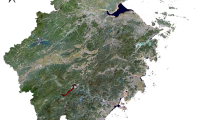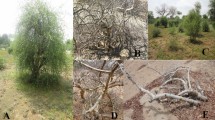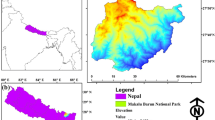Abstract
The Qinghai-Tibet Plateau is the world’s highest and largest plateau. Due to increasing demands for environment exploration and tourism, a large transitional area is required for altitude adaptation. Hehuang valley, which locates in the transition zone between the Loess Plateau and the Qinghai-Tibet Plateau, has convenient transportation and relatively low elevation. Our question is whether the geographic conditions here are appropriate for adapted stay before going into the Qinghai-Tibet Plateau. Therefore, in this study, we examined the potential use of ecological niche modeling (ENM) for mapping current and potential distribution patterns of human settlements. We chose the Maximum Entropy Method (Maxent), an ENM which integrates climate, remote sensing and geographical data, to model distributions and assess land suitability for transition areas. After preprocessing and selection, the correlation between variables and spatial autocorrelation input data were removed and 106 occurrence points and 9 environmental layers were determined as the model inputs. The threshold-independent model performance was reasonable according to 10 times model running, with the area under the curve (AUC) values being 0.917 ± 0.01, and 0.923 ± 0.002 for test data. Cohen’s kappa coefficient of model performance was 0.848. Results showed that 82.22% of the study extent was not suitable for human settlement. Of the remaining areas, highly suitable areas accounted for 1.19%, moderately for 5.3% and marginally for 11.28%. These suitable areas totaled 418.79 km2, and 86.25% of the sample data was identified in the different gradient of suitable area. The decisive environmental factors were slope and two climate variables: mean diurnal temperature range and temperature seasonality. Our model showed a good performance in mapping and assessing human settlements. This study provides the first predicted potential habitat distribution map for human settlement in Ledu County, which could also help in land use management.
Similar content being viewed by others
References
Bai W, Wang GX, Liu GS (2012) Effects of elevated air temperatures on soil thermal and hydrologic processes in the active layer in an alpine meadow ecosystem of the Qinghai-Tibet Plateau. Journal of Mountain Science 9(2):243–255. DOI: 10.1007/s11629-012-2117-z
Barve N, Barve V, Jiménez-Valverde A, et al. (2011) The crucial role of the accessible area in ecological niche modeling and species distribution modeling. Ecological Modelling 222(11):1810–1819. DOI: 10.1016/j.ecolmodel.2011.02.011
Cantor SB, Sun CC, Tortolero-Luna G, et al. (1999) A comparison of C/B ratios from studies using receiver operating characteristic curve analysis. Journal of Clinical Epidemiology 52(9):885–892. DOI: 10.1016/S0895-4356(99)00075-X
Chen J (2007) Rapid urbanization in China: A real challenge to soil protection and food security. CATENA 69(1):1–15. DOI: 10.1016/j.catena.2006.04.019
Dormann CF (2007) Assessing the validity of autologistic regression. Ecological Modelling 207(2–4):234–242. DOI: 10.1016/j.ecolmodel.2007.05.002
Elith J, Graham CH, Anderson RP, et al. (2006) Novel methods improve prediction of species’ distributions from occurrence data. Ecography 29(2):129–151. DOI: 10.1111/j.2006.0906-7590.04596.x
Feng ZM, Tang Y, Yang YZ (2008) Establishment and application of human settlements environment index model (HEI) based on GIS. Acta Geographica Sinica 63(12):1327–1336. (In Chinese)
Gong P, Liang S, Carlton EJ, et al. (2012) Urbanization and health in China. The Lancet 379(9818):843–852. DOI: 10.1093/cep/21.1.11
Hawkins BA, Diniz-Filho JAF, Mauricio Bini L, et al. (2007) Red herrings revisited: spatial autocorrelation and parameter estimation in geographical ecology. Ecography 30(3):375–384. DOI: 10.1111/j.0906-7590.2007.05117.x
Hijmans RJ, Cameron SE, Parra JL, et al. (2005) Very high resolution interpolated climate surfaces for global land areas. International Journal of Climatology 25(15):1965–1978. DOI: 10.1002/joc.1276
Immerzeel WW, Droogers P, de Jong SM, et al. (2009) Largescale monitoring of snow cover and runoff simulation in Himalayan river basins using remote sensing. Remote Sensing of Environment 113(1):40–49. DOI: 10.1016/j.rse.2008.08.010
Kuhle M (2007) Altitudinal levels and altitudinal limits in high mountains. Journal of Mountain Science 4(1):24–33. DOI: 10.1007/s11629-007-0024-5
Li JL, Sheng YW, Luo JC, et al. (2011) Remotely sensed mapping of inland lake area changes in the Tibetan Plateau. Journal of Lake Sciences 23(3):311–320. (In Chinese)
Liu FG, Zhang ZX, HOU GL, et al. (2006) Research on “step-bystep” tourism model of Qinghai-Tibet plateau. Human Geography 21(5):22–24. (In Chinese)
Lozier JD, Mills NJ (2009) Ecological niche models and coalescent analysis of gene flow support recent allopatric isolation of parasitoid wasp populations in the Mediterranean. PLoS ONE 4(6):e5901. DOI: 10.1371/journal.pone.0005901
Lu DS, Tian HQ, Zhou GM, et al. (2008) Regional mapping of human settlements in southeastern China with multisensor remotely sensed data. Remote Sensing of Environment 112(9):3668–3679. DOI: 10.1016/j.rse.2008.05.009
Lu H, Koike T, Yang K, et al. (2011) Improving land surface soil moisture and energy flux simulations over the Tibetan plateau by the assimilation of the microwave remote sensing data and the GCM output into a land surface model. International Journal of Applied Earth Observation and Geoinformation 17:43–54. DOI: 10.1016/j.jag.2011.09.006
Ma Y, Wang Y, Wu R, et al. (2009) Recent advances on the study of atmosphere-land interaction observations on the Tibetan Plateau. Hydrology and Earth System Sciences 13(7):1103–1111. DOI: 10.5194/hess-13-1103-2009
Manel S, Williams HC, Ormerod SJ (2001) Evaluating presence-absence models in ecology: the need to account for prevalence. Journal of Applied Ecology 38(5):921–931. DOI: 10.1046/j.1365-2664.2001.00647.x
McGranahan G, Balk D, Anderson B (2007) The rising tide: assessing the risks of climate change and human settlements in low elevation coastal zones. Environment and Urbanization 19(1):17–37. DOI: 10.1177/0956247807076960
Peterson AT, Vieglais DA (2001) Predicting species invasions using ecological niche modeling: new approaches from bioinformatics attack a pressing problem. Quarterly Review of Biology 51(5):363–371. DOI: 10.1641/0006-3568(2001)051
Peterson AT (2003) Predicting the geography of species’ invasions via ecological niche modeling. Bioscience 78:419–433. DOI: 10.1086/378926
Phillips SJ, Anderson RP, Schapire RE (2006) Maximum entropy modeling of species geographic distributions. Ecological Modelling 190(3):231–259. DOI: 10.1016/j.ecolmodel.2005.03.026
Qiu PF, Wu N, Luo P, et al. (2009) Analysis of dynamics and driving factors of wetland landscape in Zoige, Eastern Qinghai-Tibet Plateau. Journal of Mountain Science 6(1):42–55. DOI: 10.1007/s11629-009-0230-4
Small C, Nicholls RJ (2003) A global analysis of human settlement in coastal zones. Journal of Costal Research 19(3): 584–599.
Townsend Peterson A, Papeş M, Eaton M (2007) Transferability and model evaluation in ecological niche modeling: a comparison of GARP and Maxent. Ecography 30(4):550–560. DOI: 10.1111/j.0906-7590.2007.05102.x
Veloz SD (2009) Spatially autocorrelated sampling falsely inflates measures of accuracy for presenceonly niche models. Journal of Biogeography 36(12):2290–2299. DOI: 10.1111/j.1365-2699.2009.02174.x
Xiao F, Ling F, Du Y, et al. (2010) Digital extraction of altitudinal belt spectra in the West Kunlun Mountains using SPOT-VGT NDVI and SRTM DEM. Journal of Mountain Science 7(2):133–145. DOI: 10.1007/s11629-010-1068-5
Zheng S, Zhao X, Zhang H, et al. (2011) Atmospheric correction on CCD data of HJ-1 satellite and analysis of its effect. Journal of Remote Sensing 15(4):709–721. (In Chinese)
Author information
Authors and Affiliations
Corresponding author
Rights and permissions
About this article
Cite this article
Zhao, J., Xu, M., Lu, Sl. et al. Human settlement evaluation in mountain areas based on remote sensing, GIS and ecological niche modeling. J. Mt. Sci. 10, 378–387 (2013). https://doi.org/10.1007/s11629-013-2413-2
Received:
Accepted:
Published:
Issue Date:
DOI: https://doi.org/10.1007/s11629-013-2413-2




